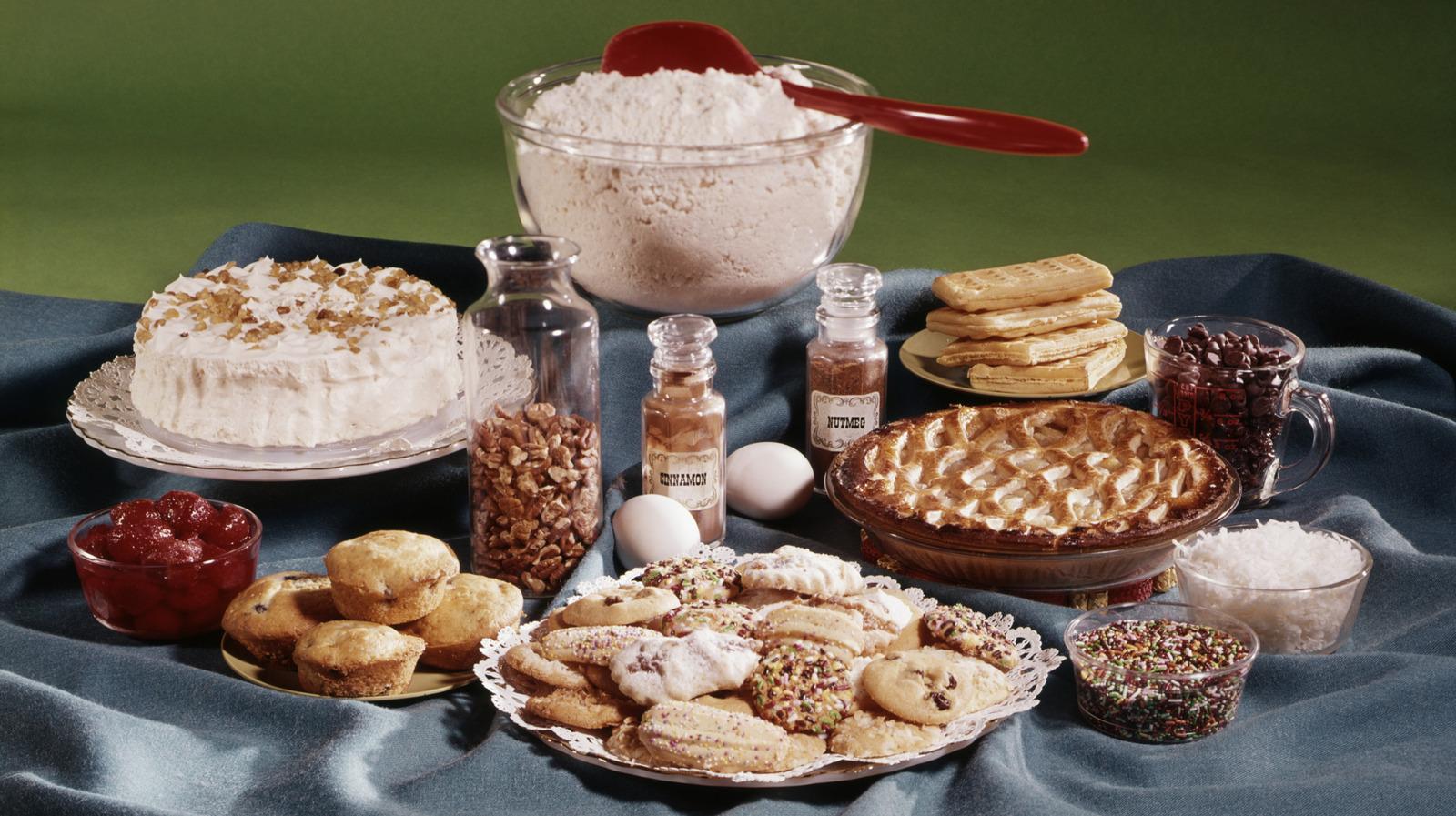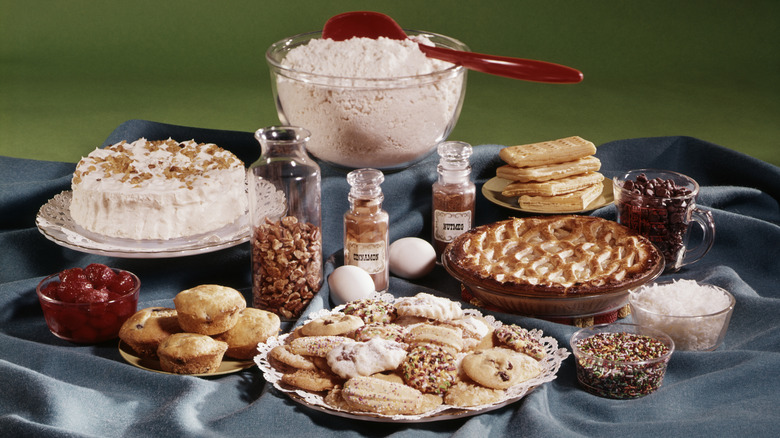
Classicstock/Getty Images
We often think of desserts as relatively modern inventions, that people deep in the past didn't have the time or resources for such indulgences. But some of the sweets you know best have been around far longer than you'd expect. The history of many of these treats has spanned nations and centuries to reach your table.
You probably don't realize just how old-school these desserts are, from the 8,000-year history of rice pudding to the cheesecake enjoyed in Ancient Rome. And, admittedly, it wasn't the everyday people who likely got to sample most of these desserts. Many of them would have been reserved for those with the money to afford ingredients like sugar and spices, although in parts of the world, these were more readily available.
We're going to look back at the history of historic desserts that you'll still recognize today. They may have changed a lot over the centuries — or in some cases, millennia — but they're still options you'll find on dessert menus, in bakeries, or made in people's homes.
Baklava
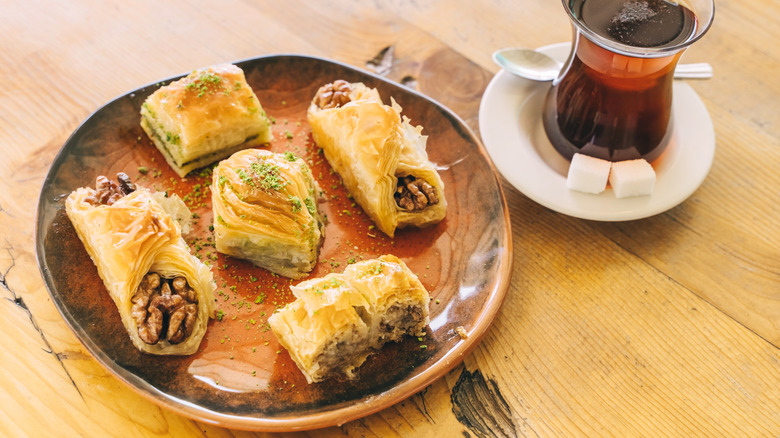
Tatiana Maksimova/Getty Images
Baklava is a staple in Middle Eastern restaurants, cut into perfect diamonds or formed into nests and drizzled with honey or sugar syrup. It might seem like a modern, Instagram-worthy dessert, but its roots reach back centuries through the Middle East and Eastern Mediterranean. What you need to know about baklava is that it's so old that the details of where and when it was invented aren't even certain.
While its exact origin is debated among Turkey, Greece, and the broader Ottoman world, the layered technique and the use of chopped nuts between layers date back at least to the Assyrian Empire around the 8th century B.C.E. Originally, the dish was made with thin flatbreads rather than phyllo pastry. Over time, baklava traveled trade routes, adapting to local preferences. It may well have existed before then, but the first reference to the dessert as it's known today was by mystic Kaygusuz Abdal roughly 500 years ago, during the Ottoman Empire.
It took a lot of skill and time to make (even more so than today, when you can buy phyllo from the store or use a food processor to chop nuts), so it was reserved for special occasions like Ramadan. Today, there are many versions of baklava, each with regional twists, such as the use of rosewater and cardamom in Iran or orange blossom water in Algeria.
Rice pudding
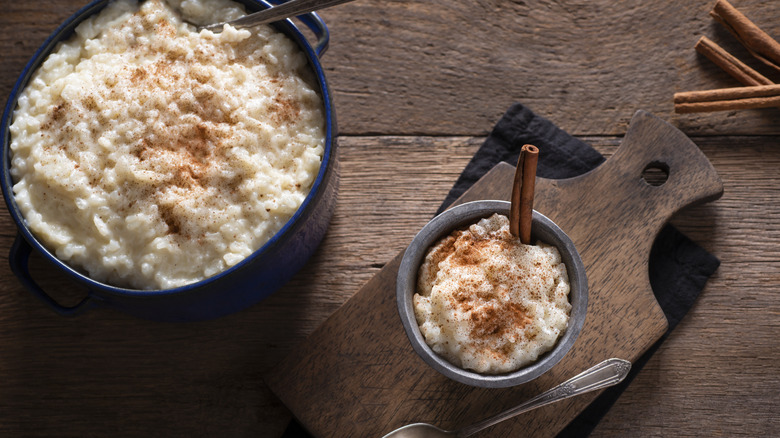
Rudisill/Getty Images
Rice pudding is one of those desserts that exists almost everywhere and under many names, with slight variations that reflect local tastes and ingredients. But it's also incredibly old — rice cultivation dates back thousands of years, and people have been simmering it with milk or water and sweeteners since ancient times.
Early versions likely appeared in China and India, where rice was abundant. In ancient India, rice pudding — known as payasa or kheer — was already a familiar dish by the mid-1st millennium B.C.E. According to Om Prakash's "Food and Drinks in Ancient India," ancient Vedic texts from this time describe it as "milk rice." It would have been made with native red rice. Another text from the same period mentions rice cooked in milk and mixed with sugar, likely cane or palm sugar by that time. This is the first written record of something very similar to today's rice pudding.
These kinds of dishes made their way through Persia and the Middle East, where they took on flavors from the region, such as rosewater, orange blossom water, and saffron. By the Middle Ages, rice pudding had made it to Europe, and in the 14th century, you could find recipes for it in English cookbooks, though they differed from current ones. At that time, recipes may have incorporated unexpected ingredients like beef broth and suet.
Ice cream

Sham Clicks/Shutterstock
You might assume that ice cream didn't exist before refrigeration, but its roots reach much deeper into the past. Its history stretches back to ancient Persia and China, where people found ways to chill sweetened concoctions with ice from mountains or underground storage pits.
In Persia around 400 B.C.E, people enjoyed a dish called faloodeh, a treat made with vermicelli, flavored with rose water and lime, and frozen with snow or ice. Meanwhile, the earliest milky versions of ice cream seem to date to around 600 to 900 A.D. in China, where fermented milk was thickened and served chilled or frozen. Around the 13th century, it made its way to the Arab world, where the freezing process was improved by using various salts, rather than relying on ice. This is a trick still used today — maybe your chemistry teacher even gave a demo on it in school.
The concept of chilling sweetened liquids eventually traveled to Italy and France by the 1600s. After time and evolution, it turned into the churned ice cream we recognize today. It came to the U.S. in the 18th century, but the industrial revolution and the development of refrigeration in the 19th century are responsible for making ice cream widely accessible.
Custard
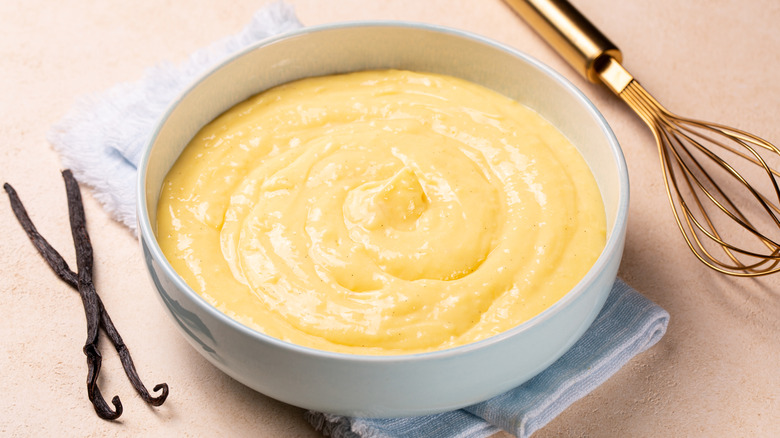
Olga Mazyarkina/Getty Images
If you've ever wondered what people really ate in the Middle Ages, they enjoyed custard. A mixture of milk or cream, sugar, and eggs, cooked until thickened, this simple formula has appeared in kitchens since at least the Medieval period. You might see it as an accompaniment to other sweet treats, but it was a luxury dessert in its own right back then.
Medieval European cooks made elaborate custards to adorn the tables of nobles, coloring them with natural dyes, such as sandalwood for red and saffron for yellow. In the late Medieval period, custard tarts were also popular. Portuguese custard tarts came about in the 13th century, while English versions date back to the 14th century.
Over time, custard's versatility allowed it to evolve into many forms, including crème brûlée in France, flan in Spain, and savory quiches found all over the world. It's still hugely popular today, which is impressive to think, given its long existence.
Apple pie
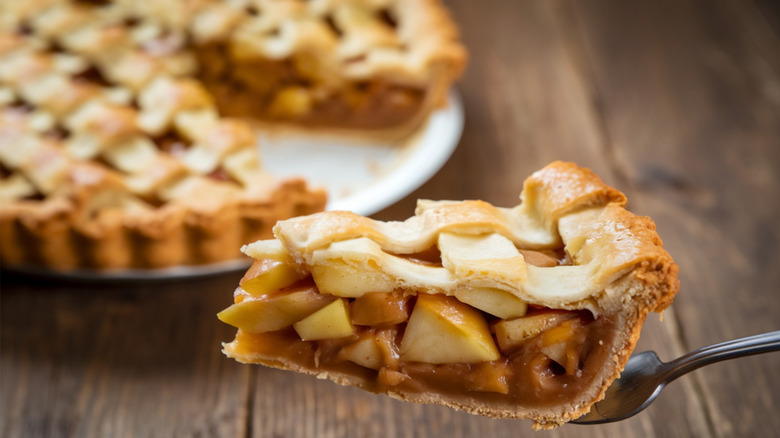
Sham Clicks/Shutterstock
Few desserts are as iconic as apple pie, but its story is far older and more global than its Americana image suggests. The untold truth of apple pie is that it isn't American at all. Not originally, anyway.
Apples themselves are native to Central Asia, and their journey to Europe brought them into medieval kitchens, where cooks first put them in pies. The first recorded apple pie recipes date back to 14th-century England, where they were often made with figs, raisins, and pears, encased in a sturdy pastry known as a coffin. Early pies weren't always sweetened, but the fruits would have made them quite sweet anyway. By the 16th century, they had become more like today's apple pies: sugary, spiced, and without dried fruits.
It wasn't until European settlers brought apple seeds and pie-making traditions to America that the dessert became the symbol it is today. The phrase "as American as apple pie" may be relatively modern, but the pie itself is beyond old-school and firmly in historic territory.
Bread pudding
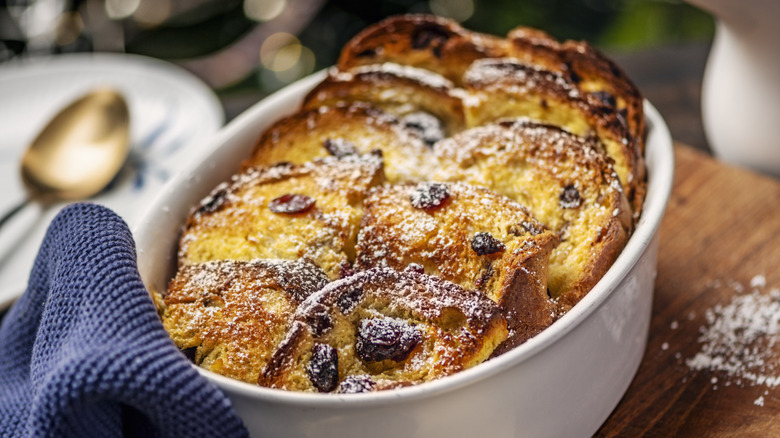
Clarkandcompany/Getty Images
Bread pudding is the definition of a thrifty dessert, giving you a way to use up stale bread rather than waste it. But that doesn't mean it's a second-rate dish. Transforming scraps into something delicious is part of what has kept bread pudding alive across centuries.
The earliest bread puddings trace back to the 11th and 12th centuries in England. At that time, the recipe was made by soaking stale bread in water and mixing it with dried fruit. Only rich households were likely to have access to any kind of sugar or sweeteners like honey. But by the 13th century, recipes were more like the ones you'd find today, using milk, eggs, and butter or other types of fat.
Bread pudding's appeal is in its simplicity and adaptability. You can add spices, fold in fruit, or sprinkle over chocolate chips. We might have far more luxurious add-on options for this dessert than people did throughout much of history, but the basics remain the same.
Trifle
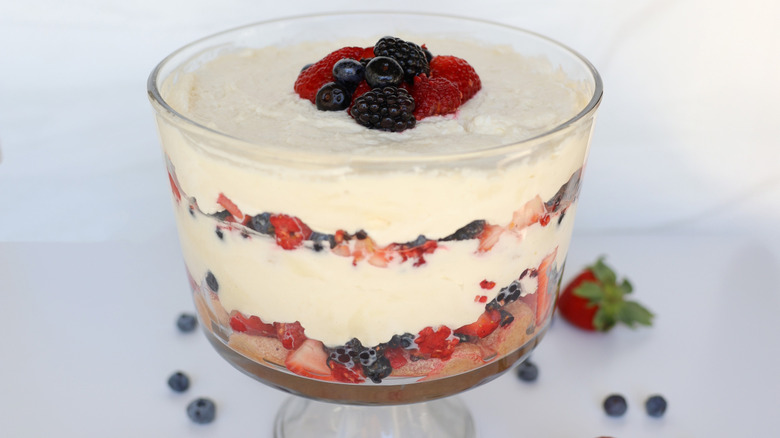
HGD21/Shutterstock
Combining cake, custard, fruit, and cream into a single-layered treat, trifle has something for everyone. It might seem like a mid-century dessert, but it's much older. The history of trifle goes back to the 1500s, when it was a much simpler affair, consisting of a sponge cake soaked in alcohol, served with custard and whipped cream. Sometimes the cream was flavored with rose water or ginger, or sweetened with sugar.
By the 1700s, trifle started to resemble the dish you'd be familiar with from today. It had defined layers, with macaroons or almond biscuits soaked in sweet wine, plus custard and whipped cream layered on top. These additions reflected changing tastes and the growing availability of ingredients like sugar and fortified wines, which helped it become a reliable showpiece for gatherings.
In the Victorian era, trifle was considered a practical dessert, too. It was an efficient way to use up leftover sponge by soaking it in alcohol to extend its life, while preventing cream from spoiling by turning it into whipped topping. Later on, jello and fruit became classic parts of this dessert, and glace cherry toppings were par for the course. Now, it's seen as retro, but it's still going strong.
Figgy pudding
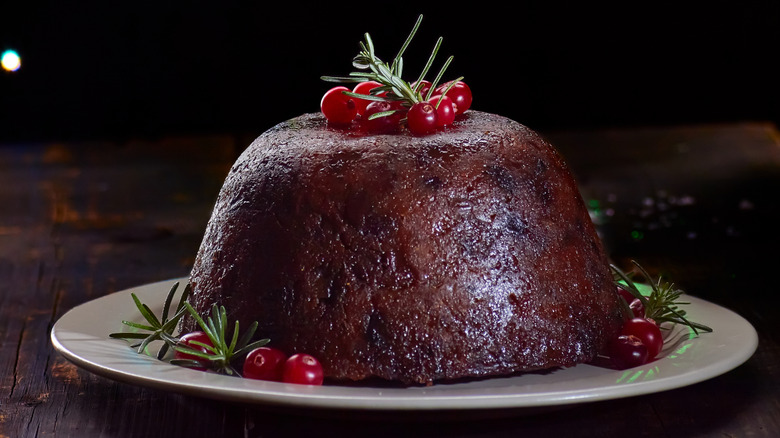
robertsre/Shutterstock
Figgy pudding — also known as Christmas pudding or plum pudding — definitely seems old school, but you might not realize quite how long it's been around. Perhaps you know it from being name-checked in the carol "We Wish You a Merry Christmas," but its origins go back much further, all the way to Medieval England.
Despite its name, figgy pudding isn't what Americans think of as pudding today; it's more like a dense, spiced cake. It also doesn't contain figs, generally. But it does contain dried fruit and is a type of steamed pudding — a British classic. Its origins date to the Middle Ages, where it started life as pottage, a mix of dried fruit, spices, broth, and wine, thickened with breadcrumbs and ground almonds. It had some of the components of the modern version, but in a more basic form.
By the Victorian era, figgy puddings were made with suet, flour, eggs, spices, and dried fruits, steamed or boiled for hours until rich and dark. They became synonymous with Christmas, and they're still eaten by the millions in the U.K. every festive season.
Cheesecake
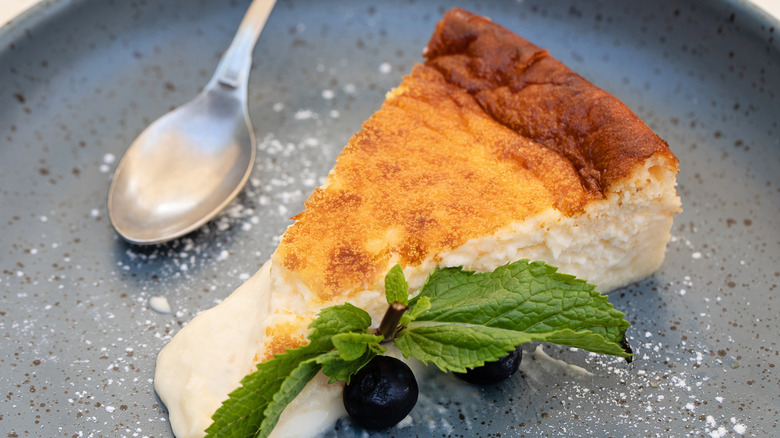
Cris Cantón/Getty Images
Cheesecake's creamy texture and tangy sweetness feel modern, but the concept of combining cheese with sweeteners has been around for millennia. Ancient Greeks are said to have served early forms of cheesecake to athletes during the first Olympic Games in 776 B.C.E., using simple ingredients like cheese, honey, and wheat, pounded together and cooked on a griddle.
The Romans took the idea and adapted it, and it's become one of the foods from the Roman Empire that lives rent-free in our heads. Early recipes are made with just a few ingredients: well-crushed cheese, wheat flour, and eggs. This mixture was shaped by hand and placed on bay laurel leaves, then cooked at low heat in a hearth under a testum — a lidded clay pot that functioned as a mini oven.
There was also a more elaborate layered cheesecake called placenta, which simply meant "flat cake" in Latin, long before it was borrowed by anatomists. It had multiple internal layers of thin pancakes filled with a sweet honey-cheese mixture. These were quite different from today's cheesecake but still speak to its origins.
Then, in Medieval Europe, variations developed using fresh curd cheese, sometimes baked into pastry crusts. It wasn't until cream cheese was invented in the 19th century that the New York-style cheesecake many of us know today took shape.
Pound cake
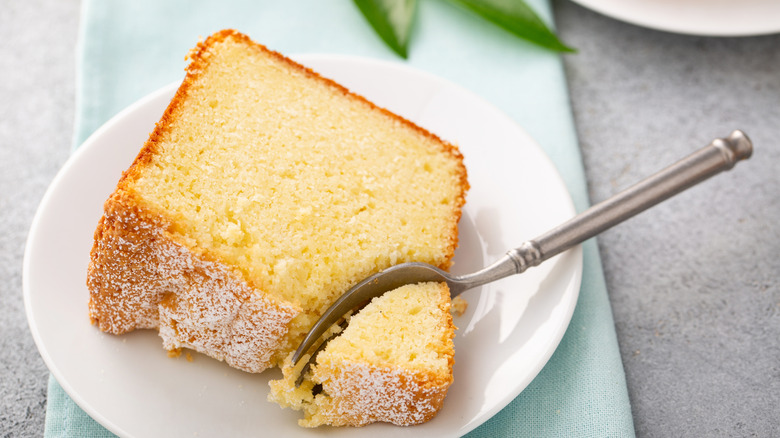
Elena Veselova/Shutterstock
Pound cake is a classic for a reason. Its name tells you everything you need to know about its ingredient ratios. Traditionally, it was made with a pound each of flour, butter, sugar, and eggs. Pound cake might seem retro, like something your grandma would make, but did you know it dates back to the 1700s?
This straightforward formula was published in 1796 in Amelia Simmons' book "American Cookery." That said, there are earlier references dating to the 1750s, and the recipe was likely brought over with colonial settlers, as the concept of dense, buttery cakes existed even earlier in Europe.
Perhaps it's the simplicity of pound cake that has made it such an enduring favorite. Without leavening beyond the air whipped into the eggs, it produces a dense but tender crumb, ideal for slicing and serving plain or with fruit and whipped cream. And you don't need any fancy ingredients to pull it off. Of course, a mixer helps to whip air into the mixture so it rises, meaning it's even easier to make today than it was back in the 18th century.
Gingerbread

Flavia Morlachetti/Getty Images
Gingerbread has a long history that stretches back to Medieval Europe. Strangely, one of the first ever written recipes for gingerbread from the 15th century doesn't contain ginger, and wouldn't be recognizable by today's standards. At the time, ginger and other spices were expensive, highly prized commodities brought along trade routes. So, it follows that ginger wouldn't have been readily available to most cooks, though it was used in some recipes.
Medieval recipes for gingerbread contained breadcrumbs rather than flour, honey to sweeten the dough, and pepper in addition to sweet spices. Later, when treacle was available, it became the sweetener of choice. Over time, gingerbread evolved into many forms, from soft cakes to crisp cookies shaped into figures. In Germany, the tradition of Lebkuchen, a spiced honey cake, became a holiday staple, while in England, gingerbread fairs feature elaborately decorated shapes.
The practice of making gingerbread houses is credited to 19th-century Germany, becoming popular after the Brothers Grimm published "Hansel and Gretel." Today, gingerbread remains tied to holiday traditions, with many of us associating it with Christmas.
Panettone
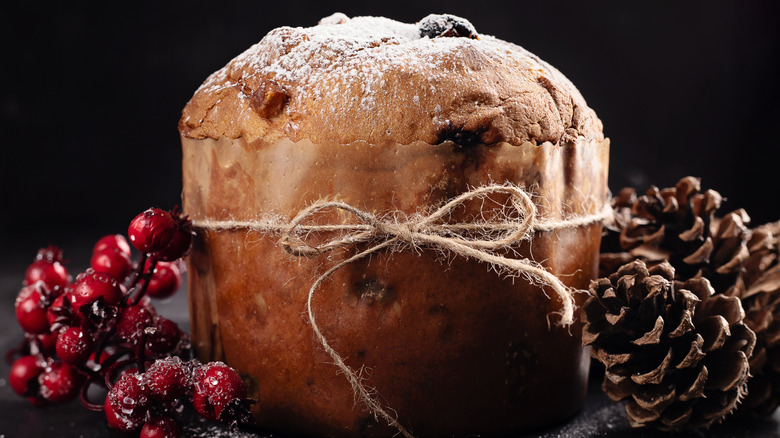
Cris Cantón/Getty Images
You might have had panettone at Christmas, especially if you have Italian family, but you may not realize quite how old it is. While festive enriched breads existed earlier, the oldest probable record of panettone dates back to 1599 in Pavia, when the Borromeo College noted in its expenditure ledger that 5 pounds of butter, 2 pounds of raisins, and 3 ounces of spices were given to a baker to make 13 loaves for students on Christmas Day. By the 18th century, writer Pietro Verri referred to it as pan de ton, meaning "luxury bread."
But it wasn't until the early 20th century in Milan that panettone evolved into the shape we recognize today. In the 1920s, baker Angelo Motta introduced the towering dome by letting the enriched dough rise three times over nearly 20 hours before baking, giving this festive favorite its airy, delicate texture despite its rich ingredients.
Another Milanese baker, Gioacchino Alemagna, soon adapted the method, and competition between these two brands led to large-scale industrial production, making panettone accessible beyond Milan. By the end of World War II, panettone had become a mainstream holiday staple across Italy, no longer reserved only for the wealthy. Despite its long history, it's still a popular treat today.
Crepes
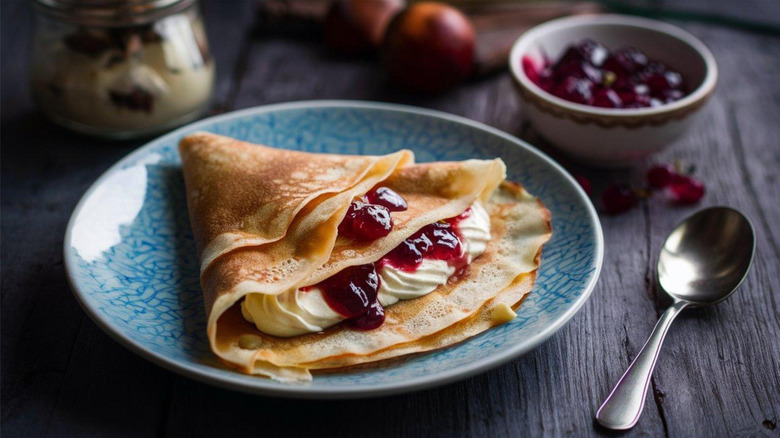
Food magic/Shutterstock
Crepes are the American pancake's fancier cousin. They're hugely popular today — in France and all over the world — but they've been around for centuries. The exact origins of crepes are disputed; some say they were invented by accident in the 13th century when a woman in Brittany spilled buckwheat porridge onto a cooking stone in the hearth. But others claim they're much older, having been offered to French pilgrims in the 5th century. Whatever the truth, they're not a new concept.
Cooking thin batter on a hot surface isn't unique to France, but crepes have become a defining feature of French cuisine. They can be eaten as a dessert, filled with sugar, jam, or Nutella, or served as a savory dish with melted cheese or sauteed mushrooms stuffed inside. Buckwheat versions, called galettes bretonnes, are especially popular in France.
Despite being made with incredibly basic ingredients — just flour, milk, and eggs — crepes feel fancy. Part of that could be that it takes good technique to get them right, and it's very easy to make them too thick and doughy. Their enduring popularity might come down to their delicious simplicity.



